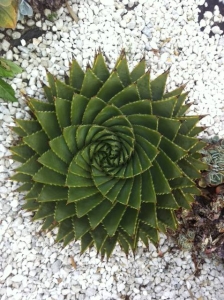Sieta Beckwith, currently living in Melbourne (but formerly from my hometown of Perth) provided this lovely spiral image and will receive a signed copy of The Shark’s Paintbrush as thanks!
When she posted it on Facebook, Sieta said,
This is a cactus-type plant that I saw in someone’s front yard on my usual route between work and local cafe in Brunswick East, Melbourne. I saw it months ago and it penetrated my pre-coffee haze so vividly and I thought it was so beautiful that I’m excited by your call to share!
As I told Sieta, this lovely creature is a most likely an aloe polyphylla, also known as the Drakensburg aloe. Here’s what the Wikipedia has to say about these beautiful plants:
Aloe polyphylla (Spiral Aloe/Kroonaalwyn/Lekhala kharetsa) is a species in the genus Aloe Aloe that is endemic to the Kingdom of Lesotho in the Drakensberg mountains. This aloe is well known for its strikingly symmetrical, five-pointed spiral growth habit [and] is commonly known as the “Spiral Aloe” in English, “Kroonaalwyn” in Afrikaans, or Lekhala kharatsa in Sesotho. The species name “polyphylla” means “many-leaved” in Greek.
Natural Habitat
The Spiral Aloe grows in high, mountainous, grassy slopes. Here it clings to rocky crevices and well-drained scree slopes. The climate is cool in the summer and in the winter the aloes are often covered in deep snow. The region also has a very high rainfall and this moisture is augmented by the clouds which engulf the Lesotho mountain peaks.
Threats and Conservation
Although it is often mentioned as an endangered species, it does not appear on the 2008 IUCN Red List. However, it is listed in CITES Appendix I, which confirms its status as an endangered and protected species. It is threatened mainly due to illegal collecting – the species is highly sought after as an ornamental but is incredibly difficult to cultivate and usually soon dies if removed from its natural habitat. Informally buying or collecting the plant is a criminal offense.
I’m guessing that this one was harvested and cultivated years ago–they have been very popular for a long time among gardeners and botanists around the world. Let’s hope that protection efforts help keep the Drakensberg aloe in its home environment as well.








